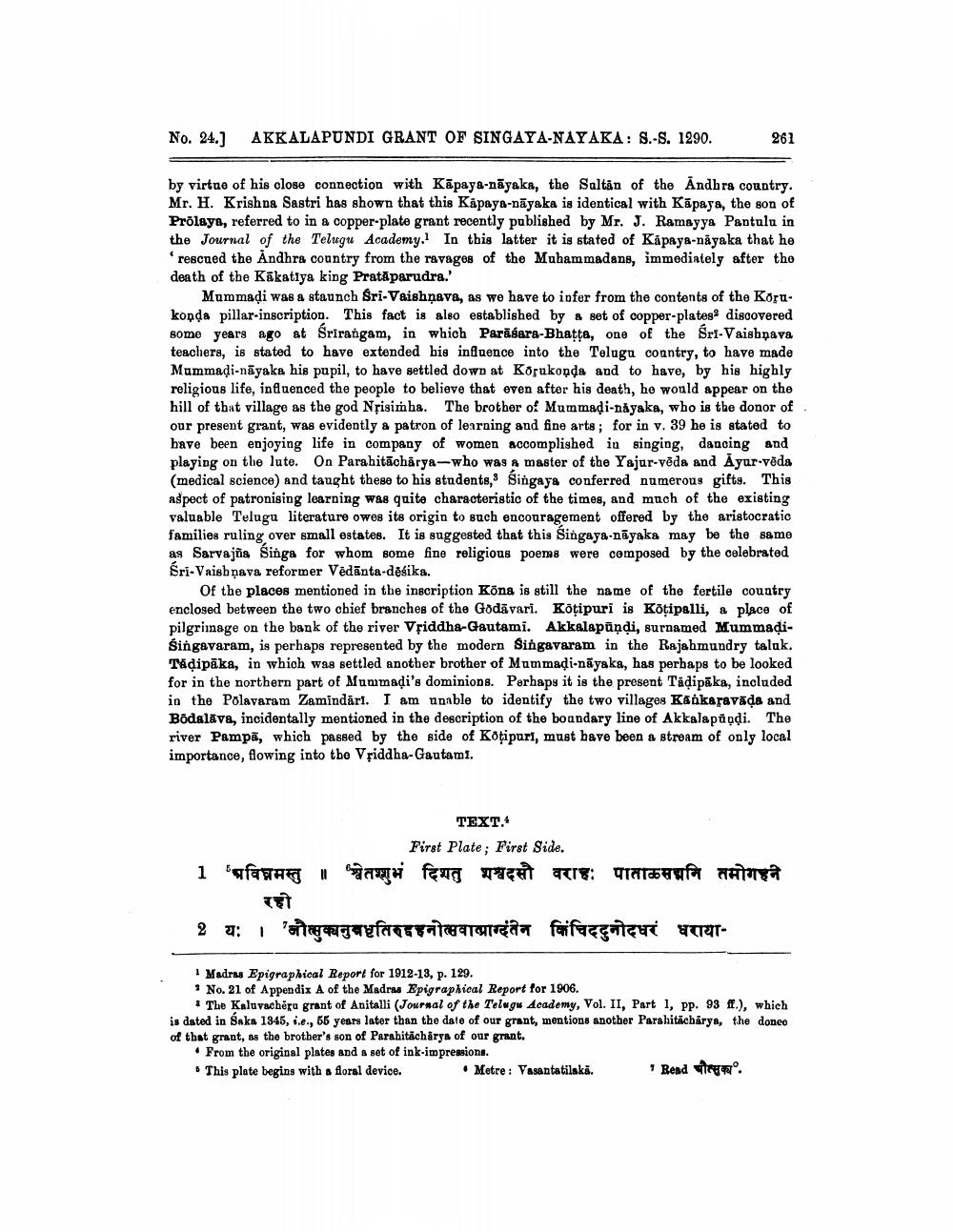________________
No. 24.)
AKKALAPUNDI GRANT OF SINGAYA-NAYAKA: S.-S. 1290.
261
by virtue of his close connection with Kāpaya-nāyaka, the Saltan of the Andhra country. Mr. H. Krishna Sastri has shown that this Kāpaya-nāyaka is identical with Kāpaya, the son of Prolaya, referred to in a copper-plate grant recently published by Mr. J. Ramayya Pantulu in the Journal of the Telugu Academy. In this latter it is stated of Kapaya-nāyaka that he
rescued the Andhra country from the ravages of the Muhammadans, immediately after the death of the Kakatiya king Pratáparudra.'
Mummadi was a staunch śri-Vaishṇava, as we have to infer from the contents of the Korukonda pillar-inscription. This fact is also established by a set of copper-plates discovered some years ago at Srirangam, in which Parāśara-Bhatta, one of the Sri-Vaishnava teachers, is stated to have extended his influence into the Telugu country, to have made Mammadi-nāyaka his pupil, to have settled down at Kogukonda and to have, by his highly religious life, influenced the people to believe that even after his death, he would appear on the hill of that village as the god Nrisimha. The brother of Mummadi-nayaka, who is the donor of our present grant, was evidently a patron of learning and fine arts; for in v. 39 he is stated to have been enjoying life in company of women accomplished in singing, dancing and playing on the lute. On Parabitāchārya-who was a master of the Yajur-vēda and Ayur vēda (medical science) and taught these to his students, Singaya conferred namerous gifts. This aspect of patronising learning was quite characteristic of the times, and much of the existing valuable Telugu literature owes its origin to such encouragement offered by the aristocratic families ruling over small estates. It is suggested that this Singaya-nāyaka may be the same as Sarvajna Singa for whom some fine religious poemes were composed by the celebrated Sri-Vaisbộava reformer Vēdānta-dēsika.
Of the places mentioned in the inscription Kõna is still the name of the fertile country enclosed between the two chief branches of the Godavari. Kotipuri is Kotipalli, a place of pilgrimage on the bank of the river Vșiddha Gautami. Akkalapāņdi, surnamed Mummațisingavaram, is perhaps represented by the modern Singavaram in the Rajahmundry talak. Tádipāka, in which was settled another brother of Mummadi-nayaka, has perhaps to be looked for in the northern part of Mummați's dominions. Perhaps it is the present Tädipāka, included in the Polavaram Zamindāri. I am unable to identify the two villages Kaakaravāda and Bödalāva, incidentally mentioned in the description of the boundary line of Akkalapüqdi. The river Pampa, which passed by the side of Kotipuri, must have been a stream of only local importance, flowing into the Vriddha-Gautami.
TEXT.
First Plate; First Side. 1 प्रविनमस्तु ॥ श्वेतशुभं दिशतु शश्वदसौ वराहः पाताळसद्यनि तमोगहने
रही ? यः । "जौत्सुक्यनुबतिरहहनोत्सवाबाग्दंतेन किंचिददुनोदधरं धराया
I Madras Epigraphical Report for 1912-13, p. 129. * No. 21 of Appendix A of the Madras Epigraphical Report for 1906.
The Kaluvachëfu grant of Anitalli (Journal of the Telugu Academy, Vol. II, Part 1, PP. 93 ff.), which is dated in Saka 1845, i.e., 55 years later than the date of our grant, mentions another Paralitacharya, the doneo of that grant, as the brother's son of Parahitacharya of our grant.
• From the original plates and a set of ink-imprensione. • This plate begins with a floral device. • Metre: Vasantatilaka. - Read पौत्सुक्य.




